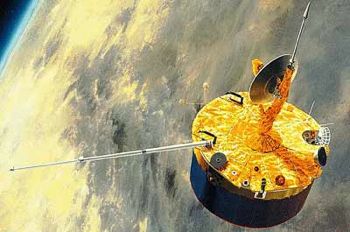
Home - Search - Browse - Alphabetic Index: 0- 1- 2- 3- 4- 5- 6- 7- 8- 9
A- B- C- D- E- F- G- H- I- J- K- L- M- N- O- P- Q- R- S- T- U- V- W- X- Y- Z
Pioneer 12
 Pioneer Venus Orbite Credit: Manufacturer Image |
Status: Operational 1978. First Launch: 1978-05-20. Last Launch: 1978-05-20. Number: 1 . Gross mass: 582 kg (1,283 lb). Height: 1.20 m (3.90 ft).
Data from the Orbiter was correlated with data from its sister vehicle (Pioneer Venus Multiprobe and its atmospheric probes) to relate specific local measurements to the general state of the planet and its environment as observed from orbit. Despite their drastically different roles, the Orbiter and Multiprobe were very similar in design. The use of identical systems (including flight hardware, flight software, and ground test equipment) and incorporation of existing designs from previous missions (including OSO and Intelsat) allowed the mission to meet its objectives at minimum cost.
The spacecraft was spin stabilized at ~15 rpm. Body mounted solar panels provided 312 W and recharged 2 x 7.5 Ah NiCd batteries. A 1.09 m despun dish antenna was used for high rate S-band communication with Earth, with low-gain omni antennas for emergency communication. 4 x 10W TWTAs powered the radar. An X-band transmitter was also incorporated for occultation measurements. Attitude determination was by sun sensors and star sensors. Nutation damping was performed with a partially filled tube of liquid Freon. The hydrazine propellant system used 7 thrusters for attitude control and orbit adjustment. A solid rocket motor providing 18 kN of thrust for Venus orbit insertion. A 4.8 m deployable boom was provided for the magnetometer.
The Pioneer Venus Orbiter carried 17 experiments (with a total mass of 45 kg). Most of the instruments were still operating when the spacecraft entered the atmosphere. They included:
- Cloud photopolarimeter - measured the vertical distribution of the clouds.
- Surface radar mapper - mapped planetary topography and surface characteristics.
- Infrared radiometer - monitored IR emissions from the Venusian atmosphere.
- Air-glow ultraviolet spectrometer - measured scattered and emitted UV radiation.
- Neutral mass spectrometer - evaluated the composition of the upper atmosphere.
- Solar wind plasma analyzer - measured properties of the solar wind.
- Magnetometer - examined Venus' magnetic field.
- Electric field detector - studied the solar wind and its interactions with the Venusian atmosphere.
- Electron temperature probe - examined the thermal properties of Venus' ionosphere.
- Ion mass spectrometer - measured the ionospheric ion population.
- Charged particle retarding potential analyzer - Studied ionospheric particles.
- Two radio science experiments - mapped Venus' gravity field.
- Radio occultation experiment - helped characterize the atmosphere.
- Atmospheric drag experiment - upper atmosphere density measurements.
- Radio science atmospheric and solar wind turbulence experiment.
- Gamma ray burst detector - monitored gamma ray burst events.
More at: Pioneer 12.
Family: Venus. Country: USA. Engines: Star 24. Launch Vehicles: Atlas, Atlas SLV-3D Centaur. Projects: Pioneer series. Launch Sites: Cape Canaveral, Cape Canaveral LC36A. Agency: NASA, NASA Ames, Hughes. Bibliography: 16, 2, 278, 296, 4016, 4022, 6, 6780, 12958.
1973 January 26 - .
- Ames requested six R4D rocket engines surplus to the Apollo program for Pioneer-Venus - .
Nation: USA.
Program: Apollo.
Spacecraft: Pioneer 12.
Ames Research Center requested that six R4D rocket engines designed for use in the Apollo program be transferred from MSC to Ames. Possibly the engines would be suitable for the retro-injection function in the Pioneer Venus series of atmospheric probe and orbiter missions. First launch was planned for early 1977.
1978 May 20 - . 13:13 GMT - . Launch Site: Cape Canaveral. Launch Complex: Cape Canaveral LC36A. LV Family: Atlas. Launch Vehicle: Atlas SLV-3D Centaur.
- Pioneer Venus Orbiter - .
Payload: Pioneer-Venus 1. Mass: 582 kg (1,283 lb). Nation: USA.
Agency: NASA Ames.
Program: Pioneer.
Class: Venus.
Type: Venus probe. Spacecraft: Pioneer 12.
Decay Date: 1992-10-22 . USAF Sat Cat: 10911 . COSPAR: 1978-051A.
The Pioneer Venus Orbiter was inserted into an elliptical orbit around Venus on December 4, 1978. After entering orbit around Venus in 1978, the spacecraft returned global maps of the planet's clouds, atmosphere and ionosphere, measurements of the atmosphere-solar wind interaction, and radar maps of 93 percent of the planet's surface. Additionally, the vehicle made use of several opportunities to make systematic UV observations of several comets. From Venus orbit insertion to July 1980, periapsis was held between 142 and 253 km (at 17 degrees north latitude) to facilitate radar and ionospheric measurements. The spacecraft was in a 24 hour orbit with an apoapsis of 66,900 km. Thereafter, the periapsis was allowed to rise (to 2290 km at maximum) and then fall, to conserve fuel. In 1991 the Radar Mapper was reactivated to investigate previously inaccessible southern portions of the planet. In May 1992 Pioneer Venus began the final phase of its mission, in which the periapsis was held between 150 and 250 km until the fuel ran out and atmospheric entry destroyed the spacecraft. With a planned primary mission duration of only eight months, the spacecraft remained in operation until October 8, 1992 when it finally burned up in Venus' atmosphere after running out of propellant.
1978 December 4 - .
- Pioneer Venus 1, Venus Orbit Insertion - . Nation: USA. Spacecraft: Pioneer 12.
1992 October 8 - .
- Pioneer Venus Burnup In Venus' Atmosphere - . Nation: USA. Spacecraft: Pioneer 12.
Back to top of page
Home - Search - Browse - Alphabetic Index: 0- 1- 2- 3- 4- 5- 6- 7- 8- 9
A- B- C- D- E- F- G- H- I- J- K- L- M- N- O- P- Q- R- S- T- U- V- W- X- Y- Z
© 1997-2019 Mark Wade - Contact
© / Conditions for Use